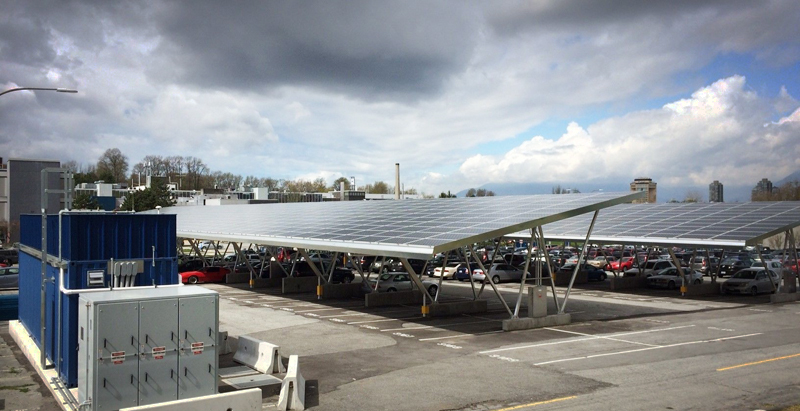Setting the Scene for Innovative Eco Solutions
Located on the scenic west coast of Canada, the British Columbia Institute of Technology (BCIT) is a public polytechnic institution of higher education. Its five campuses sprawl across the Metro Vancouver region with the main campus located in Burnaby, British Columbia.
A forward thinking institution that believes in a hands-on approach to learning, BCIT wanted to develop a renewable energy system that would have a real impact on clean transportation and incorporate innovative solar components.
The Roots of Success
It all began in early 2007, when BC Hydro, a Canadian electric utility, and SMART, a BCIT Applied Research Group, embarked on a joint research initiative to design and develop Canada's first Smart Power Microgrid at BCIT's Burnaby campus. The goal was to build a smarter, more secure power grid that would balance power generation to demand, reduce the potential for blackouts, and integrate current energy sources.
Titled the Smart Microgrid Program, the ongoing initiative includes BCIT’s Energy OASIS (Open Access to Sustainable Intermittent Sources) project involving a network of fast and standard charging stations that allow electric cars to be charged in minutes – facilitating the transition to green transportation in Canada.
Making it Happen
To make the Energy Oasis a reality, Panasonic Eco Solutions Canada was chosen to design and construct the integrated system of parking canopy structures, canopy mounted solar panels, and energy storage system.
Panasonic got to work engineering, procuring, and constructing the two parking canopies with 250 kW of solar PV – enough to power the EV charging stations. The team also designed and installed a 500 kWh energy storage and energy management system utilizing Panasonic lithium-ion batteries and a bidirectional inverter. The Panasonic Battery Energy Storage System (BESS) communicates with a Distributed Energy Management System, which learns when to buy, sell or store energy using intelligent algorithms and sends the requests to store or discharge the BESS at key times, such as peak usage or in low utility rate hours.
Collaborating with BCIT and other industry partners, Panasonic integrated the solar and battery systems into BCIT’s microgrid for a comprehensive, innovative structure.
Lasting Achievement
Recognized with a Canadian Solar Industries Association (CanSIA) Game Changer Award, the project was the first of its kind in Canada to successfully demonstrate the integration of solar power, energy storage, and electric vehicle charging stations in a grid-tied or ‘islanded’ configuration. With the team’s commissioning and post implementation support services, BCIT can count on reliable startup and continuous operation for years to come.
To learn more about Panasonic Eco Solutions and our work in North America, please visit www.panasonic.com/energysolutions.
Related Stories
| Jun 2, 2014
Parking structures group launches LEED-type program for parking garages
The Green Parking Council, an affiliate of the International Parking Institute, has launched the Green Garage Certification program, the parking industry equivalent of LEED certification.
| May 29, 2014
7 cost-effective ways to make U.S. infrastructure more resilient
Moving critical elements to higher ground and designing for longer lifespans are just some of the ways cities and governments can make infrastructure more resilient to natural disasters and climate change, writes Richard Cavallaro, President of Skanska USA Civil.
| May 20, 2014
Kinetic Architecture: New book explores innovations in active façades
The book, co-authored by Arup's Russell Fortmeyer, illustrates the various ways architects, consultants, and engineers approach energy and comfort by manipulating air, water, and light through the layers of passive and active building envelope systems.
| May 19, 2014
What can architects learn from nature’s 3.8 billion years of experience?
In a new report, HOK and Biomimicry 3.8 partnered to study how lessons from the temperate broadleaf forest biome, which houses many of the world’s largest population centers, can inform the design of the built environment.
| May 13, 2014
19 industry groups team to promote resilient planning and building materials
The industry associations, with more than 700,000 members generating almost $1 trillion in GDP, have issued a joint statement on resilience, pushing design and building solutions for disaster mitigation.
| May 11, 2014
Final call for entries: 2014 Giants 300 survey
BD+C's 2014 Giants 300 survey forms are due Wednesday, May 21. Survey results will be published in our July 2014 issue. The annual Giants 300 Report ranks the top AEC firms in commercial construction, by revenue.
| Apr 29, 2014
USGBC launches real-time green building data dashboard
The online data visualization resource highlights green building data for each state and Washington, D.C.
Smart Buildings | Apr 28, 2014
Cities Alive: Arup report examines latest trends in urban green spaces
From vertical farming to glowing trees (yes, glowing trees), Arup engineers imagine the future of green infrastructure in cities across the world.
| Apr 9, 2014
Steel decks: 11 tips for their proper use | BD+C
Building Teams have been using steel decks with proven success for 75 years. Building Design+Construction consulted with technical experts from the Steel Deck Institute and the deck manufacturing industry for their advice on how best to use steel decking.
| Apr 2, 2014
8 tips for avoiding thermal bridges in window applications
Aligning thermal breaks and applying air barriers are among the top design and installation tricks recommended by building enclosure experts.

















